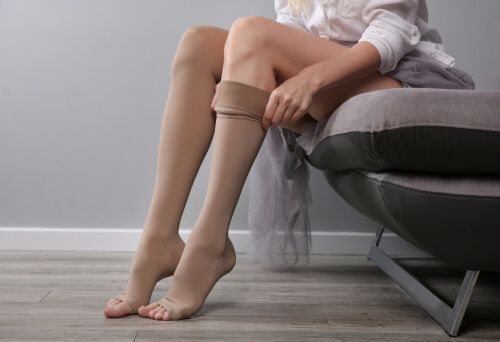Thrombosis leg
A thrombosis leg is a very unpleasant condition in which a blood clot forms in the vein. This causes various symptoms. We are happy to tell you more about the causes, symptoms, and treatment of this troublesome condition. Read on below.
What is a thrombosis leg?
You have a thrombosis leg when a blood clot forms in a vein in your leg. This blood clot can gradually grow larger, causing the blood vessel to become blocked. When this happens, your blood can no longer flow properly from your lower leg back to your heart. This causes the lower leg to swell and feel painful.

What causes it?
There are several factors that can cause thrombosis. Below is an overview.
- A change in the substances in your blood. This can happen from taking certain medications, such as the contraceptive pill.
- When the blood in your leg flows more slowly. This can happen when you have been immobile for a long time, for example after surgery.
- Damage to the wall of a blood vessel. This can result from smoking or aging.
What symptoms can occur?
There are several symptoms that can occur with a thrombosis leg. We list a few of them below.
- Your calf may become swollen and shiny.
- A thickening may occur in your calf.
- Pain in your leg
- Your leg may feel warm
- A red discoloration may appear
It is possible for a piece of the blood clot to break off. This can travel to your lungs, which may result in a pulmonary embolism. This reduces the functioning of your lungs and causes breathing problems.

How is a thrombosis leg diagnosed?
Thrombosis can be diagnosed in several ways. The doctor will first ask a number of questions and then perform a physical examination. A blood test can provide clarity on whether clots are present in your body. An ultrasound can also be used to quickly check whether blood flow is normal. A CT scan can be used to determine whether it is a case of thrombosis.
What treatments are available?
There are several ways to treat thrombosis. Anticoagulant medications are often prescribed. These medications slow down the clotting in your blood. They are also known as blood thinners. Wearing compression stockings is also part of the treatment. A compression stocking applies pressure to your leg, which helps the blood flow back to your heart. The stocking also helps to reduce symptoms. You will experience less pain and itching, and your leg will become slimmer.

Dunimed Premium Comfort Compression Stockings Groin Length - Open Toe

Dunimed Premium Comfort Compression Stockings Groin Length - Closed Toe

Dunimed Premium Comfort Compression Stockings Pressure Class 3 - Open Toe

Dunimed Premium Comfort Compression Stockings Pressure Class 2 - Open Toe

Dunimed Premium Comfort Compression Stockings Pressure Class 2 - Closed Toe

Dunimed Premium Comfort Compression Stockings Pressure Class 1 - Open Toe

Dunimed Premium Comfort Compression Stockings Pressure Class 1 - Closed Toe

- Physiotherapist
- Sports podiatrist
- Manual therapist
- Podopostural therapist
- Myofascial dry needling specialist


